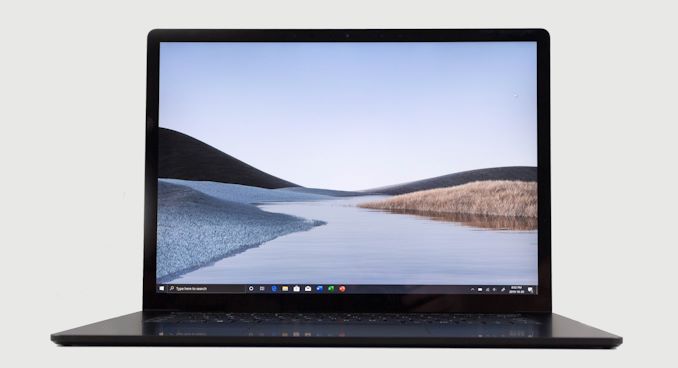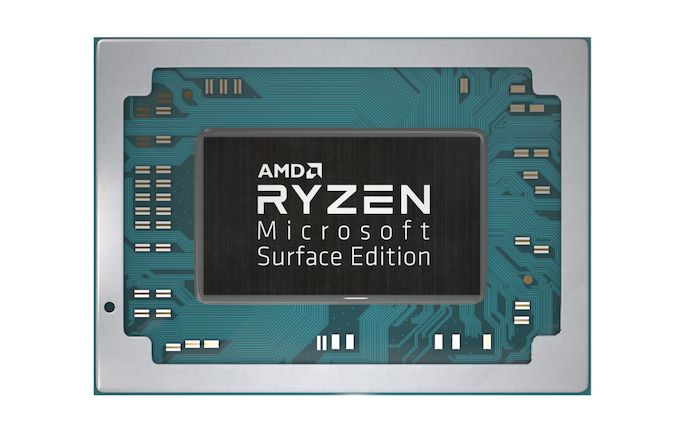The Microsoft Surface Laptop 3 Showdown: AMD's Ryzen Picasso vs. Intel's Ice Lake
by Brett Howse & Andrei Frumusanu on December 13, 2019 8:30 AM ESTFinal Words
Two laptops. Two platforms. It is rare to have a chance to see a manufacturer offer such equal footing to both AMD and Intel by outfitting a premium laptop with processors from both. It represents a rare opportunity to get to test the latest processors from AMD and Intel in a laptop in such an apples-to-apples fashion.
In the laptop space, design, cooling, and a manufacturers requirements can play a big part in how a particular chip performs, thanks to adjustable power level settings, surface temperature adjustments, and more. We have seen the lowest tier CPU outperform the highest tier CPU just by the virtue of a better cooling system, so to have processors from AMD and Intel, both of which launched in 2019, in the same chassis is a wonderful opportunity.
There aren’t too many ways to sugar coat the results of this showdown though. AMD’s Picasso platform, featuring its Zen+ cores and coupled with a Vega iGPU, has been a tremendous improvement for AMD. But Intel’s Ice Lake platform runs circles around it. Sunny Cove cores coupled with the larger Gen 11 graphics have proven to be too much to handle.
On the CPU side, no one should be too surprised by the results. We've already seen on the desktop that AMD’s Zen+ cores were competitive, but slightly slower than the previous Skylake platform; and the new Sunny Cove microarchitecture from Intel is a big step forward in terms of IPC for Intel. On purely CPU based tasks, Ice Lake really stretched its legs, and despite this being a 3.9 GHz chip, in single-threaded SPEC 2017, it managed to come very close to a 5.0 GHz Core i9-9900K with a massively higher TDP. Zen+ is outclassed here, and that showed in the benchmark results, and especially in the benchmark time. On our 8-thread SPEC 2017 run, the Ice Lake platform finished just a hair over two hours ahead of Picasso.
But things fare better for AMD on the GPU side of matters. Even though Intel has certainly closed the gap with Ice Lake's iGPU, AMD seems to continue to hold an advantage, especially on the 11 Compute Unit Ryzen Surface Edition processor found in the Surface Laptop 3. Intel has dedicated a lot more die area to the GPU and the results put them almost on equal footing with the Vega based GPU on Picasso. On the more complex GPU tasks, AMD tends to have a slight lead, and AMD’s low-level driver support also seems to benefit them on DirectX 12 based tasks. But, Ice Lake’s GPU is helped by the much quicker CPU it is coupled to, so depending on the specific test it can be even quicker.
Ice Lake does all of this with much better power efficiency as well. Overall battery life is quite a bit longer, and idle power draw is notably lower as well. Case in point: at minimum screen brightness, the Ice Lake system was pretty much only sipping power, drawing around 1.7 Watts, versus the 3.0 Watts for the AMD system.
It was fantastic to see AMD get a design win in a premium laptop this year, and the Surface Laptop 3 is going to turn a lot of heads over the next year. AMD has long needed a top-tier partner to really help its mobile efforts shine, and they now have that strong partner in Microsoft, with the two of them in a great place to make things even better for future designs. Overall AMD has made tremendous gains in their laptop chips with the Ryzen launch, but the company has been focusing more on the desktop and server space, especially with the Zen 2 launch earlier this year. For AMD, the move to Zen 2 in the laptop space can’t come soon enough, and will hopefully bring much closer power parity to Intel’s offerings as well.
Meanwhile for Intel, Ice Lake has been years in the making, and, after a long delay, it is finally here. After digging into the platform in-depth, it’s clear that Ice Lake is an incredibly strong offering from Intel. The CPU performance gains are significant, particularly because they were made in the face of a CPU frequency deficit. But the biggest gains were on the GPU side, where Intel’s Gen 11 GT2 in its full 64 Execution Unit configuration is likely the biggest single increase in GPU performance since they started integrating GPUs. It pulls very close to AMD’s Vega, closing the gap in performance to almost zero.
2019 has been a big year in the laptop space, with both Intel and AMD bringing new tools to the game. 2020 should be just as exciting, and if we’re lucky, we’ll get another chance to do this all over again.













174 Comments
View All Comments
kgardas - Friday, December 13, 2019 - link
Thanks for the great article! Intel surprised me a bit since this Ice Lake wonder looks like Zen2 or even better. Now, the only question is when we can get Ice Lake cores in Xeon E/W form?UglyFrank - Friday, December 13, 2019 - link
Coffee Lake & Zen+ were very close in IPC terms & Ice Lake & Zen 2 both had similar IPC increases from their predecessorsphilehidiot - Sunday, December 15, 2019 - link
We all knew what the CPU result was going to be, and really this is a great foot in the door for AMD for when they have a competitive mobile product. Given the relentless execution after execution, I'm hopeful for something good here. I suspect they've left laptops until last as that's where a lot of Intel's dirty tactics are in play and will be the hardest market to crack. Working with MS will undoubtedly give AMD some ideas of where they can optimise for Windows on their end and also get MS to optimise on theirs. Given that AMD are actually competitive now, I suspect Microsoft are more interested in dealing with them.The surprise for me was the GPU leap from Intel. I was expecting AMD's GPU option to be far better and Intel's to just be the usual perfunctory stuff, good only for multimedia and maybe Minecraft. That.... could be a sign of things to come, methinks.
Lolimaster - Monday, December 16, 2019 - link
Vega11 is the same as the Ryzen 2400G. Zen2+ mobile will be a major upshift.philehidiot - Tuesday, December 17, 2019 - link
I really hope you're right. It's great to finally see competition. I am actually considering upgrading my main PC for the first time in years. What I don't want is Intel abusing its market position to cane AMD in the GPU market with an inferior product.YB1064 - Tuesday, December 17, 2019 - link
I did not expect such a big improvement in IPC from Intel either. Looks like they were holding back. A desktop equivalent is going to snatch the CPU crown back from AMD. I just hope the platform price is not insane.cheshirster - Wednesday, December 18, 2019 - link
Problem is that 10nm can't hit high enough clocks.They are now backporting it to 14nm, and the result will have a questionable ... everithing other than performance in games.
eva02langley - Friday, December 13, 2019 - link
Really interesting. It just proves that AMD needs to upper their game in laptops, still it is jsut telling me that I should wait for Zen 2 mobile at this point.At least, i know what I will buy in the future.
Targon - Friday, December 13, 2019 - link
7nm AMD laptop chips are expected to show up in January at CES, potentially even shipping at that point. With the 15% IPC boost, that will help a lot. If Zen3 brings another 15% IPC boost(something that has been rumored), then in January 2021 we might see AMD beating Intel in the laptop space(since Intel doesn't improve IPC all that often).RSAUser - Friday, December 13, 2019 - link
I think it will probably be higher once Zen3 ships as node will either have had a process improvement or shrunk to 5nm.Current AMD mobile is pretty bad, hope they get competitive and bring laptop prices down.